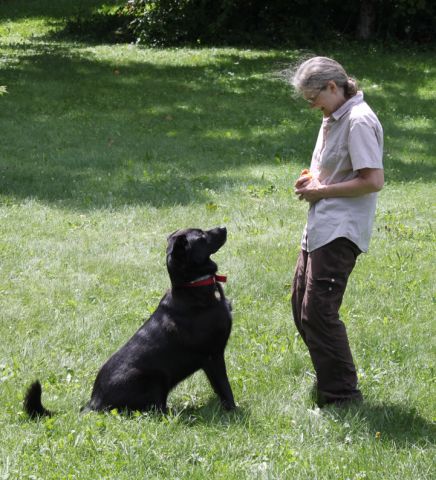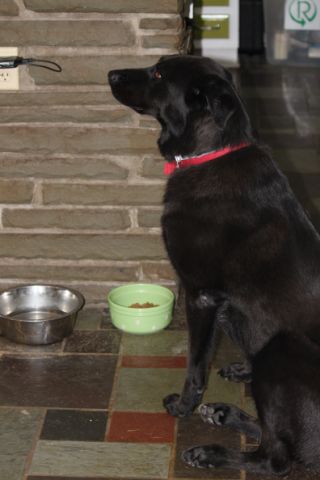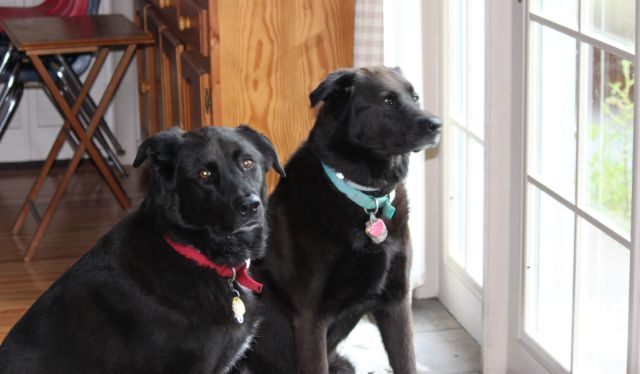
Dog Owner Coach – Every Interaction, An Opportunity!
Posted by Dustin Horton // August 23, 2013 // Local Business
Ellie and Nyah are my two Rotweiller/German Shepherd mixes. They wake in the morning around 6am to go outside. They circle near the back door, eyes focused on the prize – whatever they find rewarding about the back yard. I tell them SIT, they sit and look at me; I begin to open the door. Their muscles tense, ready to sprint so I remind them SIT and they become like stones looking at me instead of the prize. I open the door, but they don’t flinch; they’ve learned SIT means “SIT until further notice”. They darted out too soon one morning and crashed through the screen, (scary!) but today they sit like statues until I say, “OK!” They sprint out the door like Olympic runners with the starter gun.
They return. They lean forward, sniffing. It smells so good! “SIT!” I say. They sit, hoping for that reward. They don’t get the treat by staring at it. They look at me still frozen in position like drooling statues. I praise them, open my hands to soft slimy mouths. Instantly, the treats disappear from my fingers. “Ok!” Done! They are free.
Dogs are opportunists. Dogs can learn to trade a simple behavior (SIT) for something they want (a bowl of food, a run outside, a ball toss) – the beginning of good manners.
Dogs learn by doing: “I do this, I get that.” We show the dog something he wants, typically a food reward. We show him how to earn it – we teach SIT.
A reward is anything your dog cares about! Food is a reward that works for most dogs. A ball toss or a real life reward might work as well if your dog loves to play ball or rush out the door.
Dr. Ian Dunbar is credited with developing the approach: “Nothing in Life is Free.” If you can teach a child to say “Please,” you can teach your dog to SIT for something he wants. Given the nature of dog trainers, even this approach has become controversial, but the brilliance of this approach is that even busy owners can practice.
When it comes to manners, SIT is a useful command to teach your dog. When your dog learns SIT on command, use it whenever he wants something, whenever he needs to say “Please.” Use it whenever he needs to stop what he’s doing. Suddenly, each day is full of opportunities to practice SIT! Brian Kilcommons and Sarah Wilson, in their book MY SMART PUPPY, use the phrase, “Sit is It!” They made it a game!
What can go wrong with such a simple approach?
Jay says, “SIT.” Bingo sits. Jay smiles, Bingo jumps up, Jay rewards him. What behavior did Jay reward? Jumping up. Meg, Jay’s sister, tries: “SIT!” Bingo ignores her. She keeps shouting SIT, SIT,SIT and Bingo keeps ignoring her. Meg feels bad so she gives him the treat just to show him that she loves him anyway. What behavior did Meg reward? Mom comes home tired. “SIT” she says. Bingo blows her off. Mom is too tired to bother. Bingo is smart. He got his treats two out of three times without doing what was asked. What did his humans get? No one understands why Bingo won’t listen.
Classes with an experienced trainer can help. Dogs, like children, need love but they also need calm, clear, consistent expectations. There are no shortcuts, but if you trade a simple SIT command and require it each and every time you feed your dog, open the door, or toss a ball (any time he wants something) you’re off to a great start!
Margie Hillenbrand
Dog Owner Coach
607-591-7806















